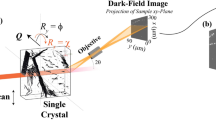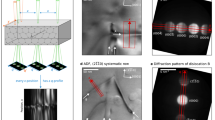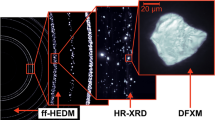Abstract
Atomic-level defects such as dislocations play key roles in determining the macroscopic properties of crystalline materials1,2. Their effects range from increased chemical reactivity3,4 to enhanced mechanical properties5,6. Dislocations have been widely studied using traditional techniques such as X-ray diffraction and optical imaging. Recent advances have enabled atomic force microscopy to study single dislocations7 in two dimensions, while transmission electron microscopy (TEM) can now visualize strain fields in three dimensions with near-atomic resolution8,9,10. However, these techniques cannot offer three-dimensional imaging of the formation or movement of dislocations during dynamic processes. Here, we describe how Bragg coherent diffraction imaging (BCDI; refs 11, 12) can be used to visualize in three dimensions, the entire network of dislocations present within an individual calcite crystal during repeated growth and dissolution cycles. These investigations demonstrate the potential of BCDI for studying the mechanisms underlying the response of crystalline materials to external stimuli.
This is a preview of subscription content, access via your institution
Access options
Subscribe to this journal
Receive 12 print issues and online access
$259.00 per year
only $21.58 per issue
Buy this article
- Purchase on Springer Link
- Instant access to full article PDF
Prices may be subject to local taxes which are calculated during checkout





Similar content being viewed by others
References
Stoneham, A. Theory of Defects in Solids (Clarendon, 1985).
Burton, C. A theory concerning the constitution of mater. Phil. Mag. 33, 191–203 (1892).
Lasaga, A. C. & Luttge, A. Variation of crystal dissolution rate based on a dissolution stepwave model. Science 291, 2400–2404 (2001).
De Yoreo, J. J. & Vekilov, P. G. Principles of crystal nucleation and growth. Rev. Mineral. Geochem. 54, 57–93 (2003).
Ma, E., Shen, T. D. & Wu, X. L. Nanostructured metals: Less is more. Nature Mater. 5, 515–516 (2006).
Kunitake, M. E., Mangano, L. M., Peloquin, J. M., Baker, S. P. & Estroff, L. A. Evaluation of strengthening mechanisms in calcite single crystals from mollusk shells. Acta Biomater. 9, 5353–5359 (2013).
Davis, K. J., Dove, P. M. & De Yoreo, J. J. The role of Mg2+ as an impurity in calcite growth. Science 290, 1134–1137 (2000).
Hÿtch, M. J., Putaux, J-L. & Penisson, J-M. Measurement of the displacement field of dislocations to 0.03 Å by electron microscopy. Nature 423, 270–273 (2003).
Barnard, J. S., Sharp, J., Tong, J. R. & Midgley, P. A. High-resolution three-dimensional imaging of dislocations. Science 313, 319 (2006).
Chen, C-C. et al. Three-dimensional imaging of dislocations in a nanoparticle at atomic resolution. Nature 496, 74–77 (2013).
Pfeifer, M. A., Williams, G. J., Vartanyants, I. A., Harder, R. & Robinson, I. K. Three-dimensional mapping of a deformation field inside a nanocrystal. Nature 442, 63–66 (2006).
Robinson, I. & Harder, R. Coherent X-ray diffraction imaging of strain at the nanoscale. Nature Mater. 8, 291–298 (2009).
Weeks, J. D. & Gilmer, G. H. Advances in Chemical Physics Dynamics of crystal growth. 157–228 (John Wiley, 2007).
Dove, P. M. & Han, N. Kinetics of mineral dissolution and growth as reciprocal microscopic surface processes across chemical driving force. AIP Conf. Proc. 916, 215–234 (2007).
Frank, F. C. The influence of dislocations on crystal growth. Discuss. Faraday Soc. 5, 48–54 (1949).
Brantley, S. L. in Kinetics of Water-Rock Interaction (eds Brantley, S. L., Kubicki, J. D. & White, A. F.) 151–210 (Springer, 2008).
Clark, J. N. et al. Ultrafast three-dimensional imaging of lattice dynamics in individual gold nanocrystals. Science 341, 56–59 (2013).
Cha, W. et al. Core–shell strain structure of zeolite microcrystals. Nature Mater. 12, 729–734 (2013).
Fienup, J. R. Phase retrieval algorithms: A comparison. Appl. Opt. 21, 2758–2769 (1982).
Antipov, A. et al. Urease-catalysed carbonate precipitation inside the restricted volume of polyelectrolyte capsules. Macromol. Rapid Commun. 24, 274–277 (2003).
Lee, J. R. I. et al. Structural development of mercaptophenol self-assembled monolayers and the overlying mineral phase during templated CaCo3 crystallization from a transient amorphous film. J. Am. Chem. Soc. 129, 10370–10381 (2007).
Clark, J. N., Huang, X., Harder, R. & Robinson, I. K. High-resolution three-dimensional partially coherent diffraction imaging. Nature Commun. 3, 993 (2012).
Paquette, J. & Reeder, R. J. Relationship between surface structure, growth mechanism, and trace element incorporation in calcite. Geochim. Cosmochim. Acta 59, 735–749 (1995).
Snyder, R. C. & Doherty, M. F. Faceted crystal shape evolution during dissolution or growth. AIChE J. 53, 1337–1348 (2007).
MacInnis, I. N. & Brantley, S. L. The role of dislocations and surface morphology in calcite dissolution. Geochim. Cosmochim. Acta 56, 1113–1126 (1992).
MacInnis, I. N. & Brantley, S. L. Development of etch pit size distributions on dissolving minerals. Chem. Geol. 105, 31–49 (1993).
Takahashi, Y. et al. Bragg X-ray ptychography of a silicon crystal: Visualization of the dislocation strain field and the production of a vortex beam. Phys. Rev. B 87, 121201 (2013).
Hirth, J. P. & Lothe, J. Theory of Dislocations (McGraw-Hill, 1968).
Pun, G. P. & Mishin, Y. A molecular dynamics study of self-diffusion in the cores of screw and edge dislocations in aluminum. Acta Mater. 57, 5531–5542 (2009).
Kitano, Y., Park, K. & Hood, D. W. Pure aragonite synthesis. J. Geophys. Res. 67, 4873–4874 (1962).
Ihli, J., Bots, P., Kulak, A., Benning, L. G. & Meldrum, F. C. Elucidating mechanisms of diffusion-based calcium carbonate synthesis leads to controlled mesocrystal formation. Adv. Funct. Mater. 23, 1965–1973 (2013).
Acknowledgements
This work was supported by FP7 advanced grant from the European Research Council (J.N.C. and I.K.R.) and an Engineering and Physical Sciences Research Council Leadership Fellowship (F.C.M. and J.I.). It was also funded through an EPSRC Programme Grant (A.S.S. and F.C.M., EP/I001514/1) which funds the Materials in Biology (MIB) consortium, and EPSRC grants EP/J018589/1 (Y-Y.K.) and EP/K006304/1 (A.N.K.). We thank Diamond Light Source for access to Beamline I-16 (MT 8187, MT 7654 and MT 7277) that contributed to the results presented here.
Author information
Authors and Affiliations
Contributions
J.N.C. and J.I. designed the project; J.I. prepared samples; J.N.C., J.I., J.M.C., A.S.S., Y-Y.K., J.M.C., G.N. and I.K.R. performed the experiments; J.N.C. performed image reconstructions; J.N.C. and I.K.R. analysed the data, J.N.C., J.I., F.C.M. and I.K.R. wrote the paper. All the authors read and commented on the manuscript.
Corresponding authors
Ethics declarations
Competing interests
The authors declare no competing financial interests.
Supplementary information
Supplementary Information
Supplementary Information (PDF 1743 kb)
Supplementary Information
Supplementary Movie 1 (AVI 2558 kb)
Supplementary Information
Supplementary Movie 2 (AVI 4026 kb)
Supplementary Information
Supplementary Movie 3 (AVI 4080 kb)
Supplementary Information
Supplementary Movie 4 (AVI 2521 kb)
Supplementary Information
Supplementary Movie 5 (AVI 2535 kb)
Supplementary Information
Supplementary Movie 6 (AVI 3956 kb)
Supplementary Information
Supplementary Movie 7 (AVI 3838 kb)
Supplementary Information
Supplementary Movie 8 (AVI 3139 kb)
Rights and permissions
About this article
Cite this article
Clark, J., Ihli, J., Schenk, A. et al. Three-dimensional imaging of dislocation propagation during crystal growth and dissolution. Nature Mater 14, 780–784 (2015). https://doi.org/10.1038/nmat4320
Received:
Accepted:
Published:
Issue Date:
DOI: https://doi.org/10.1038/nmat4320
This article is cited by
-
Harnessing dislocation motion using an electric field
Nature Materials (2023)
-
Simultaneous bright- and dark-field X-ray microscopy at X-ray free electron lasers
Scientific Reports (2023)
-
Three-dimensional in situ imaging of single-grain growth in polycrystalline In2O3:Zr films
Communications Materials (2022)
-
4th generation synchrotron source boosts crystalline imaging at the nanoscale
Light: Science & Applications (2022)
-
Three-dimensional strain imaging of irradiated chromium using multi-reflection Bragg coherent diffraction
npj Materials Degradation (2022)



